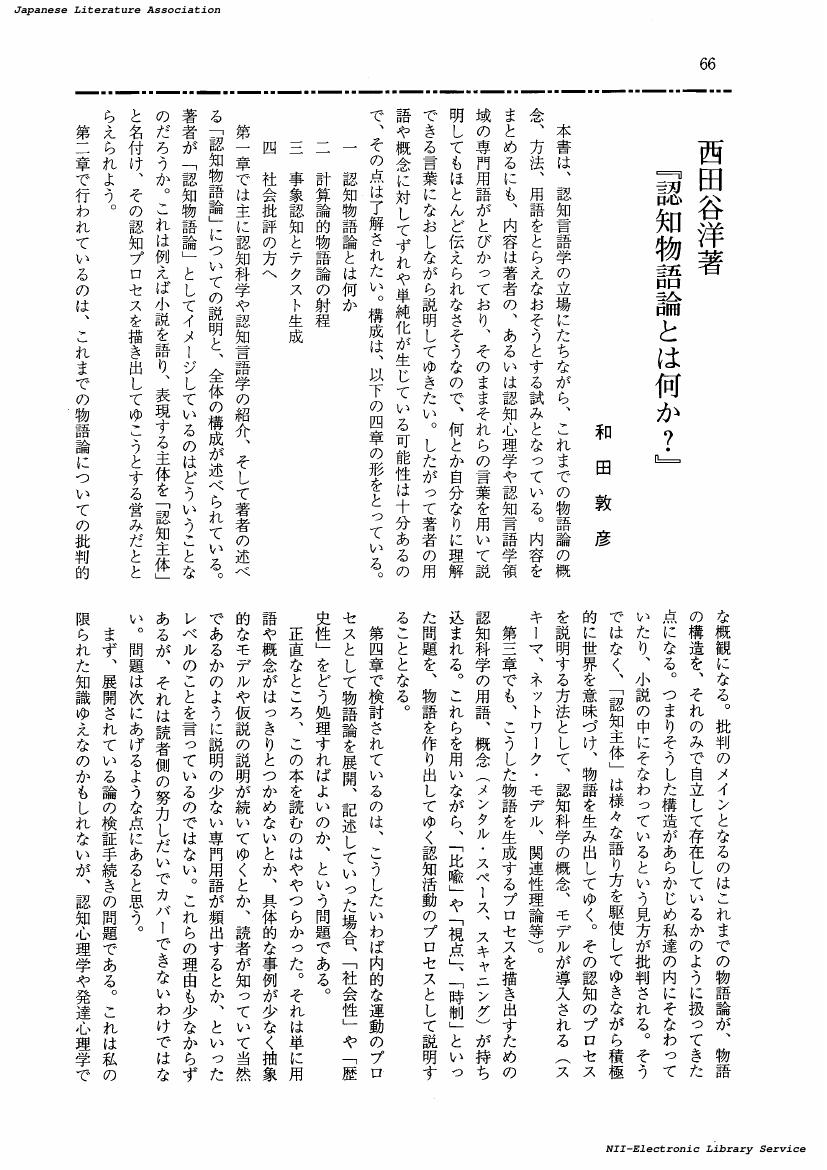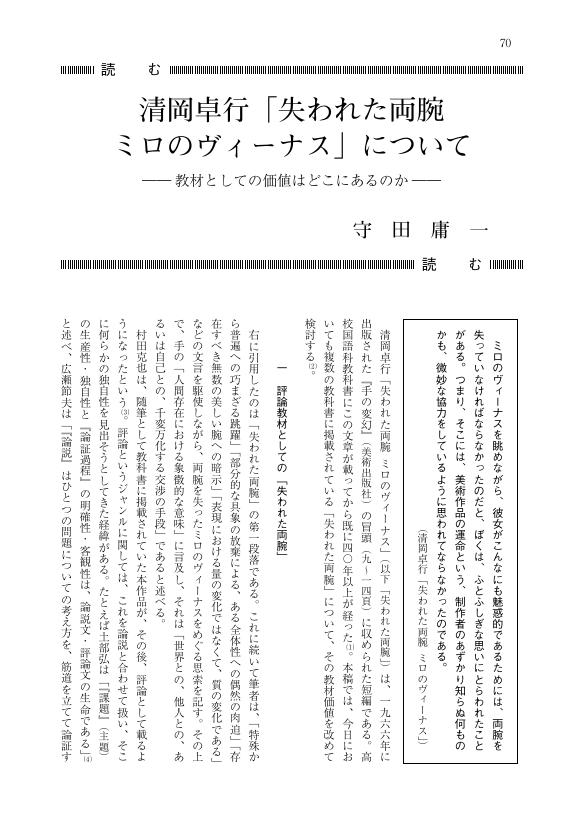- 著者
- 高橋 敏夫
- 出版者
- 日本文学協会
- 雑誌
- 日本文学 (ISSN:03869903)
- 巻号頁・発行日
- vol.40, no.5, pp.86-87, 1991
- 著者
- 小二田 誠二
- 出版者
- 日本文学協会
- 雑誌
- 日本文学 (ISSN:03869903)
- 巻号頁・発行日
- vol.37, no.8, pp.30-39, 1988
実録体小説は、写本のままで成長、変化する。この時、登場人物の付会、変容が重要な役割を果たしている。本稿では、幕末期に成立した『天一坊実記』で新たに加えられた重要な人物について、その背景を、それ以前の実録の中に探って行く。そこから見えて来るのは、謀叛を扱う実録に於ける、理想的な反逆者、為政者の型の存在である。そしてそれは、太平記読み等の、軍書講釈以来の伝統と深く関係していることも知られるのである。
- 著者
- 蒲生 芳郎
- 出版者
- 日本文学協会
- 雑誌
- 日本文学 (ISSN:03869903)
- 巻号頁・発行日
- vol.20, no.10, pp.19-27, 1971
Though Ogai's Vita Sexualis has apparently the theme of a frank confession of his own life from the viewpoint of carnal desire and the methodology of 'naturalism,' this work was, in fact, written to attempt to criticize and get over 'naturalism' by depicting a man trying to control carnal desire aginst a man controlled by it. But Ogai cannot easily be said to have succeeded in his attempt. The chief reasons of his failure seem to me sa following ; (1) he insisted too strongly upon the reason of controlling carnal desire, and (2) as the result, he completely forgot to write and express the conflicts between reason and carnal desire and the process of getting over them. Therefore, Viita Sexualis, it seems to me, remains as a story of a mere "anti-naturalism" literature and cannot be ranked as that over 'naturalism.' About eight months after Vita Sexualis, Ogai worked over his plan again and began to write long story, Seinen (A Young Man). He again took up the problem of carnal desire in this, developing the plot based upon the carnal life of its hero, Jun'ichi KOIZUMI. Comparing these two stories of the seemingly same theme, I found the mehtods contrasting in a striking way. Shizuka KANAI, a hero of Vita Sexualis, acknowledges himself to be not so handsome and attractive, and defines himself innately incapable of gettinga success in love-affairs. Accordingly there happens nothing that bothers him so much. On the contrary, Jun'ichi KOIZUMI, a hero of Seinen, is so rich and free as well as so handsome that he is always surrounded with many charming and beautiful girls and ladies. Among them he picks up Mrs. SAKAI and has a sexual connection with her. But Jun'ichi KOIZUMI cannot be addicted to the pleasures from carnal desire only as Shizuka KANAI did, but he is a man trying to lead a life for something higer than mere carnal desire. Therefore, he has to struggle against his onw sexual impetus which disturbs his higher object of life as well as his actual life. Here begins his inner conflict. Through this conflict he tries to grope for the way to get over an instinctive life controlled by carnal disere. Ogai wrote the whole aspects of a human life who tries to live manging somehow to get over his own sexual impetus. It is this conflict and the process of groping that are lacking in Vita Sexualis. The progress as a writer and the development of Ogai's literary consciousness can be seen in his succession from Vita Sexualis to Seinen. Ogai's intention is succeeded to Seinen, and he again tried to get over 'naturalism' Seinen. My further investigation into Ogai's second trial in Seinen is to be continued in my next Paper.
1 0 0 0 OA 古今集歌の本文改変について : 「立たる」から「立てる」ヘ
- 著者
- 菊川 恵三
- 出版者
- 日本文学協会
- 雑誌
- 日本文学 (ISSN:03869903)
- 巻号頁・発行日
- vol.36, no.9, pp.58-66, 1987-09-10 (Released:2017-08-01)
古今集三番歌「春霞たてるやいづこ」には「たたる」の本文を持つ伝本が存在し、この歌を再録した歌集にも「たたる」の本文を持つものは少なくない。この「たたる」の語法は万葉集の東歌・防人歌に見られるものと同一起源であり、平安初期の人々にとって風俗歌などを通じて、特殊ではあるがなじみのある表現だったのではないか。しかし、平安後期になるにつれ、なじみが薄れた結果「たてる」の本文に取って変わられたと考えられるのである。
1 0 0 0 OA 「州浜」考 : 庭園文化の影響
- 著者
- 相馬 知奈
- 出版者
- 日本文学協会
- 雑誌
- 日本文学 (ISSN:03869903)
- 巻号頁・発行日
- vol.56, no.4, pp.1-10, 2007-04-10 (Released:2017-08-01)
「にわ」と州浜台は、共に海の景色を精巧に再現していることを検証し、平安時代に発達した庭園文化の影響の大きさを州浜史の変遷から紐解いていく。州浜台は後世、嶋形(しまがた)、島台、蓬莱の島台などと名称変化することから、古来「島」と呼ばれていた庭園と密接な関係が見通される。さらに、当時の造物文化と造園文化は蓬莱山によって通底しており、両者の造形の類似性が露になっている。
1 0 0 0 OA 裏表のある言葉(上) : 『坊っちゃん』における<語り>の構造
- 著者
- Komori Yoichi
- 出版者
- 日本文学協会
- 雑誌
- 日本文学 (ISSN:03869903)
- 巻号頁・発行日
- vol.32, no.3, pp.10-17, 1983-03-10 (Released:2017-08-01)
- 著者
- 和田 敦彦
- 出版者
- 日本文学協会
- 雑誌
- 日本文学 (ISSN:03869903)
- 巻号頁・発行日
- vol.56, no.1, pp.66-67, 2007-01-10 (Released:2017-08-01)
1 0 0 0 自衛隊・自衛隊機派遣、九〇億ドル支援策に反対する声明
- 出版者
- 日本文学協会
- 雑誌
- 日本文学 (ISSN:03869903)
- 巻号頁・発行日
- vol.40, no.3, 1991
1 0 0 0 OA 〈物語〉の〈語り〉、〈小説〉の〈語り〉 ――『走れメロス』を例に――
- 著者
- 丸山 義昭
- 出版者
- 日本文学協会
- 雑誌
- 日本文学 (ISSN:03869903)
- 巻号頁・発行日
- vol.62, no.3, pp.15-25, 2013-03-10 (Released:2018-03-16)
中学校の長期安定教材「走れメロス」(太宰治)は、その劇的な展開、一見明快なテーマ、スピード感のある文章、漢語の多用と文語調の格調高い言い回しなどによって、多大な人気を保ち続ける一方で、さまざまな作品の瑕疵(たとえばメロスの人物像をめぐって)が指摘され、好きになれないという読者も少なくない。いったい、この作品をどう捉え、どのように授業で読んでいったらよいのか、考えこまざるを得ない。そこで、〈物語〉と〈小説〉の違いを念頭に置きながら、特に田中実氏の言う〈近代小説=物語+語り手の自己表出〉という観点に立ちながら、「走れメロス」を再読していきたい。〈語り手の自己表出〉を読むことは、〈機能としての語り〉を問題にすることである。〈第三項〉=〈原文〉の影の働きを前提にして読んでいかなければ、読みは常に〈物語〉を補完する方向にしか向かわない。近年の論争点である、いわゆる「悪い夢」問題は、「走れメロス」の〈機能としての語り〉をどう捉えるか、その〈語り〉追究の端的なあらわれである。読み手(主体)と読み手が捉える作品(客体)という二項の図式を前提にしているのが、従来の「走れメロス」論である。〈物語〉と〈小説〉の違いとは何かを再考しつつ、これまでの作品論・教材研究に見られる、読みの〈制度〉を明らかにした上で、読み手(主体)と捉える客体と客体そのものという三項を前提にした読みへと転轍をはかっていきたい。
1 0 0 0 源為朝論 : 「我一人、世ニアラン」
- 著者
- 須藤 敬
- 出版者
- 日本文学協会
- 雑誌
- 日本文学 (ISSN:03869903)
- 巻号頁・発行日
- vol.43, no.9, pp.12-21, 1994
『保元物語』の描く源為朝の有する孤立性について、為朝の判断・主張が保元の乱の発端から終結までの因果関係とうまく噛み合わないこと、そうした為朝が「我一人、世ニアラントセンズルエセ者」、「不孝の者」と規定されていること、為朝の弓矢が特異なものであること、等から検討を加えた。またそのことが、伝本によって為朝の扱われ方の違いに結びついていることを鎮魂の問題を含めつつ考察した。
1 0 0 0 OA 林芙美子論 : 『女の日記』『稲妻』の位置(<特集>近代女流文学)
- 著者
- 江種 満子
- 出版者
- 日本文学協会
- 雑誌
- 日本文学 (ISSN:03869903)
- 巻号頁・発行日
- vol.30, no.6, pp.44-55, 1981-06-10 (Released:2017-08-01)
Horoki (The Diary of Wandering) was Fumiko's first and best work. However, at the same time winning of this fame was seemed great fetters for her afterwards work. She had to expose herself to danger of destroying her life and pride, because her method of a first person novel dealt with shameful past of her poverty and lost loves in her youth. Therefore, after Horoki, she intended to write by a defferent method from Horoki. At the first stage of this, static style of Onna no Nikki in contract to active one of Inazuma was studied, compered with Horoki. Moreover, the position of two works among the ones after the War was considered from the view of changed style.
1 0 0 0 戦死者遺族からみる『こゝろ』:―― 軍人未亡人の家 ――
- 著者
- 北川 扶生子
- 出版者
- 日本文学協会
- 雑誌
- 日本文学 (ISSN:03869903)
- 巻号頁・発行日
- vol.64, no.12, pp.38-48, 2015
<p>『こゝろ』の「奥さん」は、先生が〈家庭〉を学び、Kの力から逃れるための指導者の役割を果たしている。しかしそのことは、「先生の遺書」では抑圧されている。当時のメディアにおける軍人未亡人のイメージを参照すると、奥さんが軍人未亡人であることで先生の自殺は大義に接続されるが、一方で、軍人未亡人は経済的・性的側面からも注目されており、その点から見れば『こゝろ』は、戦死者遺族女性の生き延びる努力の物語になる。</p>
1 0 0 0 <もと>の指向 : 中世の研究展望
- 著者
- 小峯 和明
- 出版者
- 日本文学協会
- 雑誌
- 日本文学 (ISSN:03869903)
- 巻号頁・発行日
- vol.42, no.6, pp.72-77, 1993
- 著者
- 守田 庸一
- 出版者
- 日本文学協会
- 雑誌
- 日本文学 (ISSN:03869903)
- 巻号頁・発行日
- vol.64, no.7, pp.70-73, 2015-07-10 (Released:2020-07-22)
- 著者
- 日向 一雅
- 出版者
- 日本文学協会
- 雑誌
- 日本文学 (ISSN:03869903)
- 巻号頁・発行日
- vol.40, no.1, pp.88-90, 1991
1 0 0 0 源氏物語主題論、とはなにか : 鷲山茂雄氏の新著から
- 著者
- 野村 精一
- 出版者
- 日本文学協会
- 雑誌
- 日本文学 (ISSN:03869903)
- 巻号頁・発行日
- vol.34, no.8, pp.91-93, 1985
1 0 0 0 主題論の可能性 : 「宮木が塚」を実例に(第22回大会準備号2)
- 著者
- 高田 衛
- 出版者
- 日本文学協会
- 雑誌
- 日本文学 (ISSN:03869903)
- 巻号頁・発行日
- vol.16, no.6, pp.402-408,432, 1967
- 著者
- 松澤 和宏
- 出版者
- 日本文学協会
- 雑誌
- 日本文学 (ISSN:03869903)
- 巻号頁・発行日
- vol.54, no.4, pp.76-77, 2005
- 著者
- 高木 元
- 出版者
- 日本文学協会
- 雑誌
- 日本文学 (ISSN:03869903)
- 巻号頁・発行日
- vol.43, no.10, pp.22-34, 1994
江戸読本は商品として生産された書物であるから、本文以外の装幀や板面も読まれるべきテキストとして作られている。また新刊予告の分析を通じて作者と板元との位置を計測し直し、さらに江戸読本には書式(フオーマツト)が形成されたこと、商品価値こそが書物のメディア性を保証していることなどを論じた上で、出板流通機構という構造をみずからの中に抱え込んで、書式を踏まえなければ<作者>は書物を作れなかったことを明らかにした。
1 0 0 0 形式と内容における作者(<特集><作者>・<作家> II)
- 著者
- 亀井 秀雄
- 出版者
- 日本文学協会
- 雑誌
- 日本文学 (ISSN:03869903)
- 巻号頁・発行日
- vol.41, no.1, pp.1-9, 1992
最近のテクスト論的研究は、従来の文学研究が作者を実体論的にしかとらえなかった傾向を批判して、「作者の死」を主張している。これは正当な問題意識と言えるが、しかしその反面、テクストとともに現出する「作者」あるいはテクストの生産する「作者」への関心を欠落している。本論ではその「作者」を、書く行為の段階、印刷の段階、本として流通機構に繰り込まれた段階から考察検討した。


